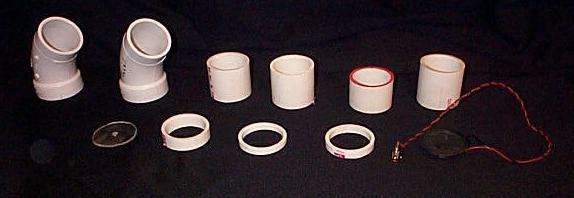

I designed and built these resonant speakers using common every availble plumbing parts.

Parts needed:
1- 2"diameter 45 degree pvc street elbow
1- 4" section of 2" pvc pipe
1- 2" diameter circle cut out of plexiglass
1- 4" diameter circle cut out of plexiglass
1- DSDP toggle switch
2- RCA phono jacks
1- 4" black 24ga wire
1- 4" white 24ga wire
1- 8 ohm 2" diameter computer speaker
sheet of 1/32" flexible plastic (get from Hobby Lobby or similar craft
store)
epoxy glue, or hot glue from glue gun
scotch tape
Assembly steps:
Assemble base:
Cut 1 inch off of 4" section of 2" diameter pvc pipe.
Looking down at your 1 inch section:
Drill holes for rca phono jacks at the 10 o'clock
and 2 o"clock positions.
Drill a hole for the toggle switch at the 6 o'clock
position
Install the rca jacks and the toggle switch TIGHT.
Use the black wire and solder the center conductor of one the phono
jacks to the center conductor of the switch.
Now solder the center conductor of the other rca phono jack to the
left side of the double pole switch.
Now solder the black wire to one side of the 2" computer speaker and
the white wire to the other
Solder the black wire to the right side of the double pole switch
Solder the white wire to the ground post of the closest rca phono jack,
cut a piece of the white wire and solder a bridge from the first phono
jack to the second phono jack ground shields.
carefully glue the speaker (cone facing up) into the 1" section of
pipe
Glue or epoxy this 1 inch section in the center of 4" diameter
pvc circle
Assemble Horn:
Place 2" circle of Plexiglass over speaker, mark exact center
of speaker on your plexiglass. Remove from your speaker and drill
a 1/8" hole. Replace plexiglass over speaker and tape in place with piece
of black electrical tape around the edge.
Place the 2" 45 degree street elbow coupling over the base and press
to fit. (note you will have to use a razor knife to trim some of
the collar to allow clearance for the rca phono jacks and the toggle switch
Assemble Slide Adjustment:
Cut another 1/2 inch piece of pvc pipe off the section of pvc pipe.
Cut the 1/32" plastic sheeting into a strip approx 2 inches wide by
about 6 inches long, form it into a circle and place inside the 1/2 inch
collar of pvc pipe, adjust this for a very tight fit and secure with
a piece of scotch tape.
Assemble the ring and collar into the pvc horn and adjust for very
tight fit. Tape the circle of sheeting in place to maintain its shape,
then remove from the horn and collar and tape both sides of your plastic
sheeting tube. Now glue the inside of the 1/2 inch collar and
place over the plastic sheeting tube. Slide it down on the tube until
it is flush with the edge. Allow glue to dry.
Final assembly:
Insert collar with slide tube into horn and base assembly.
Test:
Connect to speaker out port on your radio. Place radio in
cw mode. Turn pwr off or use sidetone only and key radio.
Adjust slide in or out until you hear the signal peak.
The other rca jack on the speaker is to allow you to connect another regular speaker in line. You may find it easier to tune on a station and then switch back to the resonant speaker as the tuning is quite sharp!
Enjoy! If you like CW as much as I do a resonant speaker will really allow for you to hear better, work weaker signals, and enjoy cw ragchews even more.
Other tips: If you have a tone generator (like the one built into a timewave DSP 599y) you can play with a voltmeter and determine the peak response of your speaker. Adjust the tone and watch a voltmeter in parallel with the speaker jack. At peak voltage read the tone setting. You can try to change the peak by adding resistance in series with speaker or by changing the height of the base assembly; you will find that there is a lot of difference even in speakers of the same manufacture. So be willing to try several different types.
WARNING! Once you build one of these little guys two things will
happen:
1. You will get a lot of notice during field day events (this
speaker can really talk!)
2. You will get lots of requests to build one for your ham buddies.